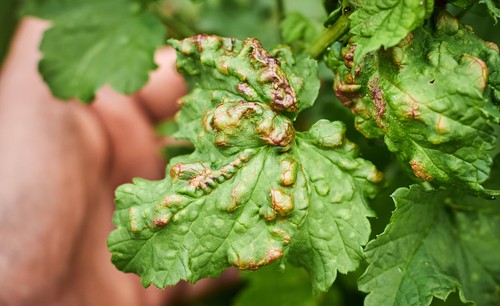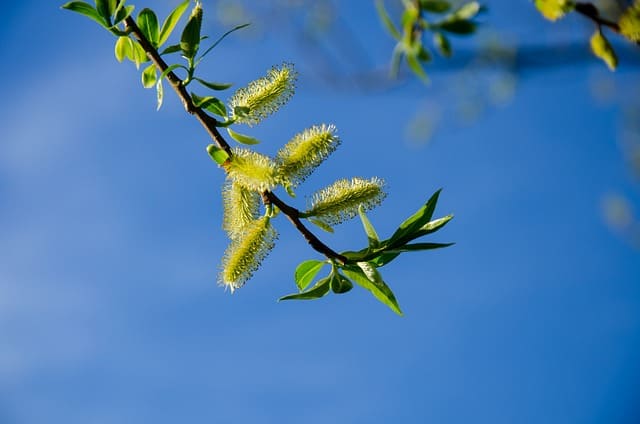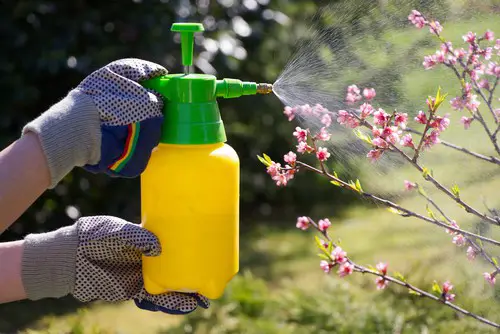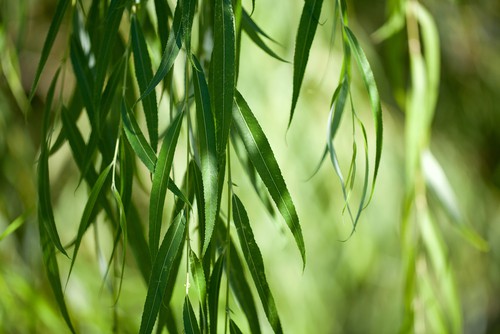Black spots on weeping willow leaves can be a common sight in gardens and landscapes. These spots can be an indication of a fungal disease that affects the tree’s health and appearance.
Understanding the causes, identifying the disease, and taking appropriate measures can help prevent the spread of the disease and keep the tree healthy.
The weeping willow is a popular tree known for its graceful, drooping branches and delicate leaves. However, these leaves are susceptible to fungal diseases that can cause black spots.
The disease can spread quickly and cause the leaves to turn yellow, wilt, and eventually fall off. This can weaken the tree and make it more vulnerable to other pests and diseases.
It’s important to identify the disease early and take steps to prevent its spread. This article will explore the causes of black spots on weeping willow leaves, how to identify the disease, and ways to prevent and treat it. It will also discuss the role of county extension offices in helping gardeners and landscapers deal with this issue.
Key Takeaways
- Black spots on weeping willow leaves can be a sign of a fungal disease that affects the tree’s health and appearance.
- Identifying the disease early and taking appropriate measures can help prevent its spread and keep the tree healthy.
- County extension offices can provide valuable resources and assistance to gardeners and landscapers dealing with black spots on weeping willow leaves.
Also see:
Understanding Black Spots on Weeping Willow Leaves

Weeping willows are beautiful and graceful trees that add a touch of elegance to any garden. However, they are susceptible to various diseases, including black spots on their leaves. These black spots are caused by several different fungi, including Cercospora and Phyllosticta.
Black spots on weeping willow leaves typically start as small, circular lesions that gradually grow larger. The spots are usually dark brown or black and may have a yellow halo around them. As the disease progresses, the leaves may become distorted, turn yellow, and eventually fall off the tree.
The fungi that cause black spots on weeping willow leaves overwinter in leaf debris on the ground, but they may also survive in buds or bark. The disease is usually aesthetic only, but if the symptoms begin early in the season, it can cause significant damage to the tree.
To manage black spots on weeping willow leaves, it is important to keep the area around the tree clean and free of debris. Raking up fallen leaves and disposing of them properly can help prevent the spread of the disease. Pruning infected branches can also help control the disease.
In severe cases, fungicides may be necessary to control black spots on weeping willow leaves. However, it is important to read and follow the instructions carefully, as some fungicides can be harmful to the tree and the environment.
Overall, understanding black spots on weeping willow leaves is crucial for maintaining the health and beauty of these trees. By taking proper care and using appropriate management techniques, gardeners can keep their weeping willows looking their best.
Black Spots on Weeping Willow Leaves – 2 Common Problems
Fungal Diseases

Black spots on the leaves of a weeping willow tree are often caused by fungal diseases.
The disease is usually aesthetic only, unless the symptoms begin early in the season. Black leaf spots on willows can also be caused by several other fungi, as reported by Gardening Know How.
One of these is willow scab, which is caused by the fungus Venturia salciperda. Willow scab doesn’t usually cause serious harm unless the black canker fungus (Glomerella miyabeanais) is also present.
Environmental Factors
Environmental factors can also cause black spots on weeping willow leaves. Overwatering is one of the most common causes of fungal diseases in willow trees.
Temperature changes can also have an impact on the health of a weeping willow tree. High humidity and warm temperatures can create a moist environment that is ideal for fungal growth. In contrast, low humidity and cold temperatures can cause the leaves of a weeping willow tree to turn black and fall off.
Identifying the Black Spot Disease
Weeping willow trees are susceptible to various diseases, including black spot diseases that can cause black spots on the leaves. Identifying the specific black spot disease is crucial to determine the appropriate management method. Here are some of the most common black spot diseases that affect weeping willow trees:
1. Black Leaf Spot

Black leaf spot is a fungal disease that causes small, irregular gray target-like spots on the leaves. These black spots can later turn black and cause the centers of the leaves to fall out, leaving ragged holes.
The spots may also have a yellow margin. Black leaf spot is caused by several different fungi, including Ascochyta, Ciborinia, and Marssonina.
2. Black Canker
Black canker is another fungal disease that can cause black spots on the leaves of weeping willow trees. The first symptoms of black canker are black spots or lesions on the leaves.
Over time, the leaves will die and fall from the tree. Black canker may spread to the twigs around the infected area, eventually resulting in growths, or cankers, forming where twigs meet branches.
3. Other Related Diseases
Weeping willow trees may also be affected by other diseases that can cause black spots on the leaves. Rust, powdery mildew, tar spot, and crown gall are some of the other diseases that can cause black spots on the leaves of weeping willow trees.
Rust is a fungal disease that causes orange or yellow spots on the leaves, while powdery mildew causes a white powdery substance to form on the leaves. Tar spot is a fungal disease that causes black spots to form on the leaves, and crown gall is a bacterial disease that causes abnormal growths to form on the roots.
Identifying the specific black spot disease affecting the weeping willow tree is crucial to determine the appropriate management method. It is recommended to consult with a professional arborist or horticulturist for proper diagnosis and treatment.
Effects of Black Spots on Weeping Willow
Impact on Leaves

Black spots on weeping willow leaves can have several effects on the tree. The most noticeable effect is the appearance of the leaves. Black spots can make the leaves look unsightly and affect the aesthetic appeal of the tree. The spots may also cause the leaves to yellow and fall off prematurely, leading to defoliation.
When black spots appear on the leaves early in the growing season, it can cause the tree to wilt and stunt its growth. This is because the tree is expending energy to produce new leaves to replace the damaged ones.
The tree may also become more susceptible to other diseases and insect infestations due to the weakened state caused by the black spots.
Impact on Tree Health
Black spots on weeping willow leaves can also have an impact on the overall health of the tree. If the tree experiences defoliation for several seasons due to black spots, it can weaken the tree and make it more vulnerable to other diseases and pests.
The tree may also become more susceptible to environmental stressors such as drought or extreme temperatures.
It is important to note that black spots on weeping willow leaves do not necessarily mean that the tree is unhealthy. Trees can still be healthy even with black spots on their leaves. However, if the black spots are severe and the tree is experiencing defoliation, it is important to take action to prevent further damage to the tree.
Prevention of Black Spots on Weeping Willow Leaves
Weeping willows are susceptible to black spots on their leaves, which can be caused by fungal diseases such as black leaf spot and black canker. While these diseases can be treated with fungicides, prevention is always better than cure.
Here are some preventative measures that can be taken to avoid black spots on weeping willow leaves.
1. Proper Watering

Weeping willows require consistent and sufficient watering to maintain their health. Overwatering can lead to root rot and other fungal diseases, while underwatering can stress the tree and make it more susceptible to diseases.
It is recommended to water the tree deeply once a week, especially during dry spells. A good rule of thumb is to water the tree for 30 minutes using a soaker hose or drip irrigation system.
2. Maintaining Good Air Circulation
Good air circulation is essential for preventing fungal diseases on weeping willow trees. Trees that are planted too closely together or in areas with poor air circulation are more prone to fungal diseases.
To maintain good air circulation, it is important to space out the trees properly and prune any branches that are crossing or rubbing against each other. This will also help to prevent the spread of diseases from one tree to another.
3. Regular Pruning
Regular pruning is an important part of maintaining the health of weeping willow trees. Dead or diseased branches should be removed as soon as possible to prevent the spread of diseases.
Pruning also helps to improve air circulation and sunlight penetration, which can help to prevent fungal diseases. It is recommended to prune weeping willow trees in late winter or early spring before new growth begins.
By following these preventative measures, it is possible to avoid black spots on weeping willow leaves caused by fungal diseases. Proper watering, good air circulation, and regular pruning are essential for maintaining the health of weeping willow trees.
Treatment of Black Spots on Weeping Willow Leaves
1. Using Fungicides

Fungicides can be used to treat black spots on weeping willow leaves. They work by killing the fungus that causes the disease. However, it is important to note that fungicides are not a cure for the disease, but rather a way to manage it.
There are many different types of fungicides available, and it is important to choose one that is specifically designed to treat black spots on weeping willow leaves.
When using fungicides, it is important to follow the instructions on the label carefully. Fungicides should be applied at the first sign of the disease and reapplied every two to three weeks throughout the growing season.
It is also important to use the correct amount of fungicide, as using too little will not be effective, and using too much can be harmful to the tree.
2. Removing Infected Parts
Another way to treat black spots on weeping willow leaves is to remove infected parts of the tree. This includes any leaves that have black spots on them, as well as any branches that are infected.
Infected branches should be pruned back to healthy wood, and any debris should be removed from around the base of the tree. This will help to prevent the disease from spreading to other parts of the tree.
When pruning infected branches, it is important to use clean, sharp tools. This will help to prevent the spread of the disease to other parts of the tree. After pruning, the tools should be disinfected with a solution of one part bleach to nine parts water.
3. Adjusting Soil pH
Black spots on weeping willow leaves can also be caused by an imbalance in the soil pH. Weeping willows prefer a slightly acidic soil with a pH between 5.0 and 6.5. If the soil is too alkaline, the tree may not be able to absorb the nutrients it needs, which can lead to black spots on the leaves.
To adjust the soil pH, a soil test can be performed to determine the current pH level. If the pH is too high, sulfur can be added to the soil to lower it. If the pH is too low, lime can be added to raise it. It is important to follow the instructions on the product carefully, as adding too much can be harmful to the tree.
Conclusion
In conclusion, black spots on weeping willow leaves are a common problem that can be caused by various factors, including fungal diseases, environmental stress, and poor maintenance practices. While these spots may not necessarily kill the tree, they can weaken it and affect its aesthetic value in a landscape setting.
To prevent black spots on weeping willow leaves, it is important to maintain good tree health through proper irrigation, fertilization, and pruning practices. Removing dead or diseased branches and leaves can also help prevent the spread of fungal diseases.
Additionally, planting the tree in full sun and moist soil can help it withstand fungal diseases such as black leaf spot.
If black spots do appear on weeping willow leaves, it is important to identify the cause and take appropriate action. This may include applying a fungicide, improving irrigation and drainage, or adjusting fertilization practices. It is important to note that some fungal diseases may require professional intervention to effectively manage.
Overall, preventing and managing black spots on weeping willow leaves requires regular maintenance and attention to the tree’s health. By following best practices and addressing issues promptly, homeowners and landscapers can help ensure the longevity and beauty of their weeping willow trees.
Frequently Asked Questions
How do you treat willow leaf spots?
Willow leaf spots are a common problem that can be treated with a fungicide. The fungicide should be applied at the first sign of the spots and should be reapplied according to the manufacturer’s instructions.
In addition to using fungicides, it is important to keep the tree healthy by removing dead leaves and branches and ensuring that the tree is properly watered and fertilized.
Why does my willow tree have spots on the leaves?
Willow trees can develop spots on their leaves for a variety of reasons, including fungal diseases like black canker and willow scab, as well as bacterial infections.
Environmental factors like drought, poor soil conditions, and excessive heat can also contribute to the development of leaf spots. Identifying the underlying cause of the spots is important in determining the best treatment approach.
How do you treat black canker on willows?
Black canker is a fungal disease that can be treated with a fungicide. It is important to remove infected branches and leaves and dispose of them properly to prevent the spread of the disease.
In severe cases, it may be necessary to remove the entire tree to prevent the disease from spreading to other trees in the area.
How do you cure willow tree rust?
Willow tree rust is a fungal disease that can be treated with a fungicide. It is important to remove infected leaves and branches and dispose of them properly to prevent the spread of the disease.
In addition to using fungicides, it is important to keep the tree healthy by ensuring that it is properly watered and fertilized.
What does willow scab look like?
Willow scab is a fungal disease that causes dark spots on the leaves of willow trees. These spots can be brown or black and can cause the leaves to wilt, shrivel up, and die.
In severe cases, the fungus can spread to the stem tissue at the bases of leave petioles, where it forms olive brown, velvety, spore masses.
What is the best treatment for black canker on willow?
The best treatment for black canker on willow is to apply a fungicide according to the manufacturer’s instructions. It is important to remove infected branches and leaves and dispose of them properly to prevent the spread of the disease.
In severe cases, it may be necessary to remove the entire tree to prevent the disease from spreading to other trees in the area.

Hey, I’m Lisa and I’ve been an avid gardener for over 30 years. I love writing, talking and living in the garden! Feel free to connect with me on my socials below

